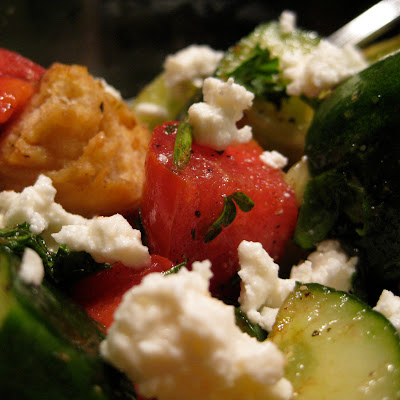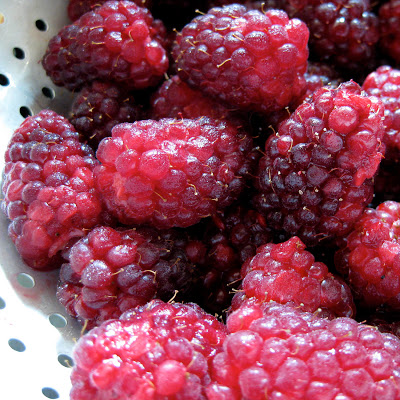
Catching the Elusive Ingredient:
An essay and one easy summer recipe
Bread fascinates and charms not just because it is the staff of life, blah de blah, but because it transforms. Flour, yeast, and water (okay a pinch of salt too, and sometimes olive oil) combine to make dough, kneaded from shaggy mess to supple mound. Add heat and the results literally make my mouth water (That actual drool, I get it now just writing about it.) More than flour, more than dough—Boule, baguette, batard… bread! These are not new observations; bread is an ancient and mysterious magic trick.∗
Baking bread, documenting the process and the end result, and then posting it online where anyone with a computer or an internet capable phone can see it—that is a more recent phenomenon. But, as the thousand upon thousand of food blogs attest, even THIS is not a revelation. Why do it then? Why is the eating not enough? When did I start scorning my food because I don’t think it is pretty enough?
In the last two months I have posted two sets of recipes and photographs. I assure you that that is not all I have eaten. And almost everything I’ve eaten has been made at home with as many seasonal and fresh products as possible. Sometimes I even took pictures. But I haven’t shared. More accurately, I haven’t shared this way. Neighbors, friends, and the fellow—I’ve shared with them. I’ve been eating and living, but, to extend the bread metaphor, this month has been somewhere between shaggy mess and supple mound: all the ingredients are there but I’m afraid to knead, afraid to apply heat. So you (oh elusive reader) get no recipe, no photos, and I have nothing to show that I was here.
Maybe I’m supposed to fake it and pretend that food, like life, is easy and that the end result is always pretty. But tarting up my tart to make friends and influence people sucks the joy out of it and, I’m convinced, some of the fruity goodness too. But today I remembered that I took pictures of what I cooked or baked or threw together for years before I started posting them online. My tarts may not make the world love me but a salad, difficult to photograph but cool and fresh and low in calories, will sustain me. What’s that elusive ingredient? I don’t know, I haven’t found it yet. But until then I’ll keep tasting and when the weather cools back down I’ll continue baking. But in the meantime here’s an idea to use up the little nubbins of bread that are too small or too stale to eat as is.
A Variation on Panzanella Salad
The problem with bread is that it doesn’t last. If I wolf it down all at once I’m left wanting more but if I dole out a loaf over several days I run the risk of mold or, worse, disappointment. It saddens me when bread I baked goes stale. How can something so good go so bad? But do I toss it to the curb? Heck no. I make croutons. And if there isn’t quite enough bread left to justify croutons I throw the nubbins in the freezer and wait until there is.

Croutons
Bread (stale, fresh, rye, wheat, white, sourdough, savory, or sweet—I don’t think it matters) cut into bite size chunks.
Enough olive oil to lightly coat
Salt and Pepper to taste
Seasonings (garlic powder, paprika, a dried herb blend such as Herbs De Provence—again it varies depending on what I have and how spicy I feel)
Toss bread with enough olive oil to coat, add seasonings and toss again. Then either spread seasoned bread out onto a cookie sheet and bake in a preheated 325 degree oven until lightly browned and crisp throughout (usually somewhere between 15-30 minutes depending on the size of the croutons and the type of bread). For a small batch I’ll brown the croutons in my cast iron skillet on the stovetop. Sometimes I cook the croutons too long and while not burned they are almost unbearably crunchy. That is a good time to make Panzanella
>

Panzanella
You can make panzanella with regular bread but I think it gets too soggy. I like to use croutons because it softens them up enough that you can still hear the conversation but you’re not left with mush. The key is garden fresh, juicy, tasty tomatoes – the winter supermarket variety will not do. The rest, I think, is a matter of taste.
Serves 2 hungry people or 4 peckish ones
2 tomatoes, cut into bite sized pieces
½-1 cucumber, chopped into bite size pieces
1 tablespoon white balsamic vinegar
1 tablespoon balsamic vinegar
2 tablespoons olive oil
1 cup croutons (see above) or stale bread pieces
Minced basil or parsley or a combination of the two
Salt and pepper to taste
½ cup feta or fresh mozzarella balls or ¼ cup shaved Parmesan or Romano (the cheese is optional, but I love cheese.)
In a medium bowl whisk together vinegars, olive oil, salt and pepper. Toss in cucumber and tomato and let sit for a few minutes. Add parsley and basil and croutons. Toss lightly. Allow the croutons to absorb some of the dressing, about five or ten minutes. If desired top with cheese and serve.

∗ For a more thorough and thoughtful meditation on bread you might want to check out
Peter Reinhart’s TED presentation.
 Mmmm, grilled cheese. Nothing says back to school like a grilled cheese sandwich.
Mmmm, grilled cheese. Nothing says back to school like a grilled cheese sandwich.











